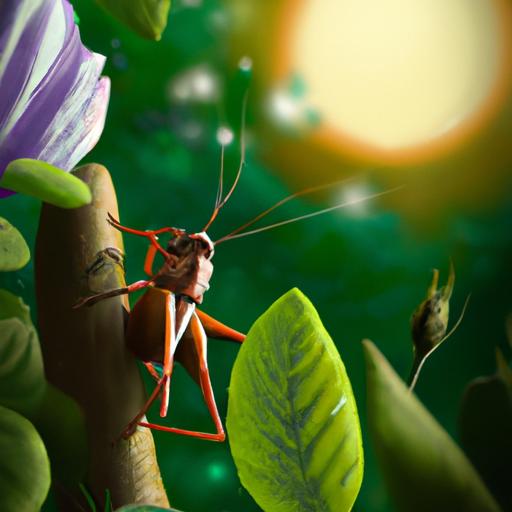Have you ever heard the chirping of crickets on a warm summer’s night and wondered what it meant? Or have you ever been curious about the science behind these chirps? Well, you’ve come to the right place! In this article, we’ll be exploring the fascinating world of cricket chirps, from what they are and why they exist to how they are made and how different species of crickets make different chirps.
We’ll also explore the frequency of cricket chirps, how temperature affects them, and how we can use technology to listen to them.
So, let’s get started!
Table of Contents
Short Answer
Crickets chirp as a form of communication.
They use their chirps to attract mates, establish territory, and warn of danger.
Males use a combination of chirps and clicks to create a courtship song.
Female crickets can then recognize and respond to the particular sound of the male they are interested in.
The chirps also act as a way for crickets to identify other crickets of the same species.
What Is a Cricket Chirp?
A cricket chirp is a sound that male crickets make to attract a mate and communicate with other crickets in the area.
The sound is created when a male cricket rubs its wings together, creating a chirping sound that is used to attract females and let other males know that they are present.
The sound is unique to each species of cricket and can even vary in frequency depending on the temperature.
This allows crickets to communicate over long distances as the sound carries further in warmer temperatures.
The chirping is a mating ritual and can also be used to identify different species of crickets.
For example, the snowy tree cricket chirps at a rate of about 16 chirps per second while the common field cricket chirps at a rate of about 25 chirps per second.
What Is the Purpose of a Cricket Chirp?

Crickets use chirping to communicate and attract mates, which is why we often hear them singing on summer nights.
Male crickets are the ones responsible for the chirping, and they do this by rubbing their wings together in a specific way, known as stridulation.
The sound created by this stridulation is unique to each species of cricket, and can be used to identify which type of cricket is making the noise.
But why do crickets chirp? Well, the sound is actually a mating ritual, and serves to attract female crickets.
Male crickets create a loud, pulsating sound that can travel over long distances, allowing them to find potential mates from far away.
The frequency of a crickets chirp also changes depending on the temperature, so crickets can communicate with each other over long distances.
By adjusting the pitch of their chirps, crickets can send messages to other crickets in the area.
In addition to being used as a mating ritual, cricket chirps are also used to ward off predators and to alert other crickets of danger.
When a cricket senses danger, it will chirp at a higher frequency, sending out a warning to other nearby crickets.
How Do Crickets Make a Chirp?
When it comes to understanding the science behind why crickets chirp, one must first understand how they make the chirping sound.
Male crickets use their wings to create the chirping sound that is so familiar to many of us.
Specifically, the wings are rubbed together to generate the sound.
The wings are specially adapted to make this possible, as they have a ridged area known as the scraper.
This area is used to rub against the other wing, creating a sound.
The frequency of the chirp will depend on the species of cricket as well as the temperature of the environment.
This is how crickets can communicate with each other over long distances.
The chirping sound that male crickets make is used for a variety of purposes.
Perhaps the most well-known purpose is to attract potential mates.
This chirping sound acts as a mating call and can help crickets find one another in the wild.
Additionally, the chirping sound is also used to ward off other male crickets from the area.
Male crickets will use the chirping sound to signal to other males that they are present and to stay away.
It is also possible to use the chirping sound to identify different species of crickets.
Different species of crickets will have different chirp frequencies, so the sound can be used to determine which species is present in a given area.
Overall, crickets chirp for a variety of reasons.
They use the chirping sound to attract potential mates, to ward off other males, and also to identify different species of crickets.
The chirping sound is created by rubbing the wings together, and the frequency of the chirp will vary depending on the species of cricket and the temperature of the environment.
What Is the Frequency of a Cricket Chirp?

When it comes to understanding the science behind cricket chirps, one of the most important aspects to consider is the frequency of the chirp.
Every species of cricket has a different frequency of chirping, which is largely determined by the size and shape of the cricket’s wings.
Generally, the larger the cricket, the lower the frequency of the chirp.
This means that crickets of different sizes and species can be identified by the frequency of their chirps.
But the frequency of cricket chirps isn’t just determined by the size of the cricket.
In fact, the frequency of cricket chirps is also affected by the temperature.
As the temperature rises, the frequency of cricket chirps increases.
This is because the cricket’s wings vibrate more quickly, resulting in a higher frequency.
This phenomenon is known as the “Kelvin effect,” and it means that crickets can communicate over longer distances because their chirps are easier to hear.
In addition to the frequency of cricket chirps, the volume of the chirp is also important.
Crickets chirp louder when they are trying to attract a mate, which is why they tend to be louder in the summer months when they are actively looking for mates.
This is also why crickets tend to be quieter in the winter months, when they don’t have to worry about attracting a mate.
Overall, the frequency and volume of cricket chirps is an important part of understanding the science behind the sound.
By knowing the size, temperature, and time of year, you can better understand why crickets chirp and how they use the chirps to communicate with each other.
How Does Temperature Affect a Cricket Chirp?
The frequency of a cricket chirp is affected by the temperature of its environment.
This is because colder temperatures cause the muscles in the cricket’s wings to contract more slowly, resulting in a lower frequency chirp.
Conversely, higher temperatures cause the muscles to contract more quickly, resulting in a higher frequency chirp.
The frequency of a cricket’s chirp can also vary depending on the species.
For example, the southern house cricket has a chirp frequency of around 2.5 kHz, while the snowy tree cricket has a frequency of around 8 kHz.
Temperature is also important when it comes to a cricket’s ability to communicate with other crickets.
As the temperature increases, the range of a cricket’s chirp increases as well.
This is because the higher frequency chirps produced in warmer temperatures can travel further than the lower frequency chirps produced in colder temperatures.
By adjusting their chirp frequency depending on the temperature, crickets can communicate with each other over long distances.
The temperature also affects the way female crickets respond to the chirps of male crickets.
Female crickets are drawn to higher frequency chirps produced in warmer temperatures, while lower frequency chirps produced in colder temperatures are ignored.
This helps male crickets to find suitable mates and ensure the survival of their species.
Overall, temperature plays an important role in the way crickets chirp.
By understanding the science behind the chirps, we can better appreciate the amazing adaptations that crickets have made to survive in their environment.
What Is the Difference Between Species of Crickets?

When it comes to understanding why crickets chirp, it is important to look at the differences between species of crickets.
Each species of cricket has its own unique chirping pattern, which is used to attract mates and communicate with other crickets in the area.
For example, the common field cricket species will chirp at a rate of approximately one chirp per second.
On the other hand, the snowy tree cricket species will chirp at a rate of approximately two chirps per second.
Another difference between species of crickets is the frequency of their chirps.
The common field cricket species will have a chirp frequency of about 2,000 Hz, while the snowy tree cricket species will have a chirp frequency of about 3,000 Hz.
This helps crickets of the same species identify each other from a distance, as the chirp frequency acts as a form of identification.
Furthermore, the temperature also plays an important role in the frequency of the chirps.
Warmer temperatures will cause the chirp frequency to increase, while cooler temperatures will cause the chirp frequency to decrease.
This is a useful way for crickets to communicate over longer distances, as the temperature can be used to adjust the chirp frequency accordingly.
In conclusion, each species of cricket has its own unique chirping pattern that is used to attract mates and communicate with other crickets in the area.
The frequency of the chirps also differs among species, with warmer temperatures causing the chirp frequency to increase and cooler temperatures causing the chirp frequency to decrease.
Understanding the science behind why crickets chirp can help us better appreciate the unique behavior of these small insects.
How Can We Use Technology to Listen to Cricket Chirps?
Thanks to advances in technology, its now possible to listen to cricket chirps with relative ease.
By using special microphones, recorders, and other audio equipment, scientists and researchers are able to capture the sounds of chirping crickets and analyze them in detail.
This is especially helpful for studying the behaviors of different species of crickets, as each species produces a unique sound.
In addition to specialized audio equipment, researchers can also use mobile apps that are designed to measure and analyze cricket chirps.
These apps use algorithms to accurately measure the frequency and duration of cricket chirps, which can be used to identify different species.
Its also possible to use apps to record cricket chirps for later analysis.
Listening to cricket chirps is also useful for amateur naturalists.
By using simple tools such as an ordinary microphone or a smartphone, its possible to record cricket chirps in the wild and analyze them to identify different species.
This is particularly useful for identifying crickets in areas where they are not typically found, such as in urban areas.
Overall, the ability to listen to cricket chirps has allowed us to gain a better understanding of these fascinating insects and how they interact with their environment.
By using technology to listen to cricket chirps, we can gain insight into the behavior and ecology of many different species of crickets.
Final Thoughts
Crickets chirp for a variety of reasons, from attracting mates to communicating with other crickets and identifying different species.
The frequency of the chirp also changes based on the temperature, allowing crickets to communicate over long distances.
We can use technology to listen to cricket chirps and better understand the science behind them.
Now that you know more about why crickets chirp, you can go out and listen for yourself – and see if you can identify different species of crickets!

